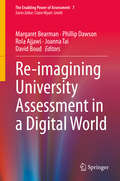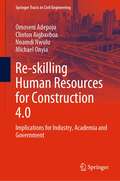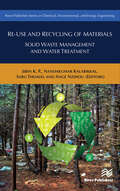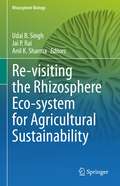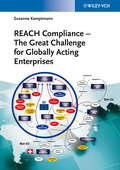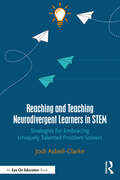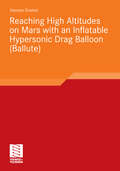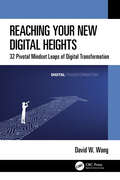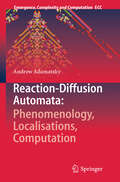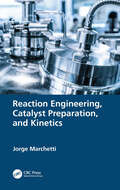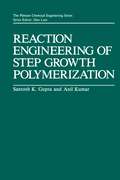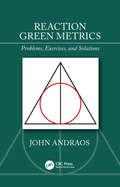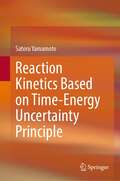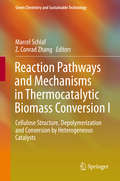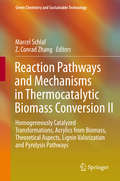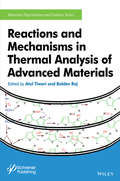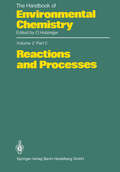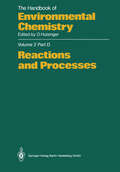- Table View
- List View
Re-imagining University Assessment in a Digital World (The Enabling Power of Assessment #7)
by Margaret Bearman David Boud Rola Ajjawi Phillip Dawson Joanna TaiThis book is the first to explore the big question of how assessment can be refreshed and redesigned in an evolving digital landscape. There are many exciting possibilities for assessments that contribute dynamically to learning. However, the interface between assessment and technology is limited. Often, assessment designers do not take advantage of digital opportunities. Equally, digital innovators sometimes draw from models of higher education assessment that are no longer best practice. This gap in thinking presents an opportunity to consider how technology might best contribute to mainstream assessment practice.Internationally recognised experts provide a deep and unique consideration of assessment’s contribution to the technology-mediated higher education sector. The treatment of assessment is contemporary and spans notions of ‘assessment for learning’, measurement and the roles of peer and self within assessment. Likewise the view of educational technology is broad and includes gaming, learning analytics and new media. The intersection of these two worlds provides opportunities, dilemmas and exemplars. This book serves as a reference for best practice and also guides future thinking about new ways of conceptualising, designing and implementing assessment.
Re-skilling Human Resources for Construction 4.0: Implications for Industry, Academia and Government (Springer Tracts in Civil Engineering)
by Omoseni Adepoju Clinton Aigbavboa Nnamdi Nwulu Michael OnyiaThis book examines the burgeoning revolution in the construction industry known as Construction 4.0, the attendant need for re-skilling human resources, and key stakeholders' roles in developing the required skills for Construction 4.0. It views the lack of 21st-century skills and skills gap in the industry as significant challenges limiting the uptake and implementation of Construction 4.0 technologies, especially in developing countries. In order to determine the skills required, this book examines the critical technologies of Construction 4.0, such as building information modelling (BIM), robotic construction, 3D printing and drones, which have transformed the construction industry, thereby creating digital, intelligent and sustainable construction solutions. Furthermore, the book considers the benefits, risks and relevant skills required to implement Construction 4.0 technologies.
Re-Use and Recycling of Materials: Solid Waste Management and Water Treatment
by Jibin K. P. Nandakumar Kalarikkal Sabu Thomas Ange NzihouIn recent years, a considerable amount of effort has been devoted, both in industry and academia, towards the recycling and reuse of materials. Most nations are now trying to reduce the amount of waste materials, through the proper recycling of materials.Re-Use and Recycling of Materials will help readers to understand the current status in the field of waste management, as well as what research is taking place to deal with such issues.Technical topics discussed in the book include: Municipal solid waste management Recycling of WEEE Waste to industrially important product like lignin and cellulose Recycling of agriculture waste Polymer and plastic recycling
Re-Use and Recycling of Materials: Solid Waste Management and Water Treatment
In recent years, a considerable amount of effort has been devoted, both in industry and academia, towards the recycling and reuse of materials. Most nations are now trying to reduce the amount of waste materials, through the proper recycling of materials.Re-Use and Recycling of Materials will help readers to understand the current status in the field of waste management, as well as what research is taking place to deal with such issues.Technical topics discussed in the book include: Municipal solid waste management Recycling of WEEE Waste to industrially important product like lignin and cellulose Recycling of agriculture waste Polymer and plastic recycling
Re-visiting the Rhizosphere Eco-system for Agricultural Sustainability (Rhizosphere Biology)
by Udai B. Singh Jai P. Rai Anil K. SharmaThe present book entitled, “Re-visiting the Rhizosphere Eco-system for Agricultural Sustainability” written by experts in the field, provides a comprehensive and consolidated state-of art overview of various aspects of rhizosphere biology, ecology and functioning. The role of rhizosphere microbial diversity in enhancing plant health and plant-microbe beneficial symbioses is discussed. Main topics include the diversity of plant-associated microbes in the rhizosphere, below-ground communication among the plant, soil, insects and microbes, rhizosphere ecosystem functioning, rhizosphere engineering, recruitment of microorganisms in the rhizosphere, mycorrhizal fungal symbiosis, positive interaction of the plants with the beneficial soil microorganisms for inducing the plant growth, conferring abiotic and biotic stress tolerance and modulating several pathways of the plants for the proper establishment and revitalization in the degraded and contaminated soils or negative likes the host-pathogen interactions leading to the disease development in plants. Further chapters focus on the role of signaling during the different stages of the plant-microbe coexistence, in symbiotic or pathogenic relationships, in quorum sensing, microbial signaling and cross-talk, bio-film formation, and antimicrobial peptides. The book also discusses the application of microbes in biodegradation of xenobiotic contaminants, bioremediation of heavy metals, sustainable agriculture and soil health, biological control of insect pests and plant pathogens, and the latest tools of omics which offer pioneering approaches to the exploration of microbial structure and function, secretome, holobiome, below-ground interaction, and microbial cooperation for sustainable food production and enhanced resource acquisition. Descriptions of cutting-edge techniques and novel approaches make this book unique in the area of rhizosphere biology. This is a useful reading material for researchers and students of microbiology, agriculture, ecology, and rhizosphser studies.
REACH Compliance: The Great Challenge for Globally Acting Enterprises
by Susanne KamptmannThe only book to not only discuss the technicalities of the European REACH chemicals registration process, but also to directly address the resulting business risks and business solutions. In this text for practitioners, the author pulls together the key knowledge needed to successfully run a business under REACH, distilling thousands of pages of official documentation, and incorporating experiences from different-sized enterprises in a global context. Starting with the basics of the REACH framework, she explains the entire process on how to register with the European ECHA office with a particular emphasis on small and medium-sized businesses. Along the way, she describes key milestones and presents sample documents from real case studies. The final part of the book addresses strategies to ensure a reach-compliant operation, including recommendations for in-house processes as well as communicating with suppliers and downstream users. As a result, managers in the pharmaceuticals and chemicals industries will learn how to operate their companies in full compliance with REACH standards.
REACH Compliance: The Great Challenge for Globally Acting Enterprises
by Susanne KamptmannThe only book to not only discuss the technicalities of the European REACH chemicals registration process, but also to directly address the resulting business risks and business solutions. In this text for practitioners, the author pulls together the key knowledge needed to successfully run a business under REACH, distilling thousands of pages of official documentation, and incorporating experiences from different-sized enterprises in a global context. Starting with the basics of the REACH framework, she explains the entire process on how to register with the European ECHA office with a particular emphasis on small and medium-sized businesses. Along the way, she describes key milestones and presents sample documents from real case studies. The final part of the book addresses strategies to ensure a reach-compliant operation, including recommendations for in-house processes as well as communicating with suppliers and downstream users. As a result, managers in the pharmaceuticals and chemicals industries will learn how to operate their companies in full compliance with REACH standards.
Reaching and Teaching Neurodivergent Learners in STEM: Strategies for Embracing Uniquely Talented Problem Solvers
by Jodi Asbell-ClarkeProviding salient stories and practical strategies, this book empowers educators to embrace the unique talents of neurodivergent learners in science, technology, engineering, and mathematics (STEM). An exploration of the exciting opportunities neurodiversity presents to build an innovative workforce is grounded in a large body of research from psychology, neuroscience, and education. Author Jodi Asbell-Clarke presents individual examples of neurodivergent journeys in STEM to establish evidence-based connections between neurodiversity and the types of innovative problem-solving skills needed in today’s workforce. The featured stories come directly from the author’s many years in inclusive classrooms with STEM teachers along with interviews from many neurodivergent professionals in STEM. Teachers will learn how to embrace the unique brilliance and potential of the neurodivergent learners in their classroom, working against historic marginalization and deficit-based perspectives of neurodiversity within the education system. Featuring illustrations of classroom-designed tools and materials alongside basic strategies to support executive function and emotion in learning, this book will help you nurture the talents of your neurodivergent learners and recognize their unique potential within STEM. Ideal for K-12 classroom teachers, special educators, learning specialists, psychologists, and school administrators.
Reaching and Teaching Neurodivergent Learners in STEM: Strategies for Embracing Uniquely Talented Problem Solvers
by Jodi Asbell-ClarkeProviding salient stories and practical strategies, this book empowers educators to embrace the unique talents of neurodivergent learners in science, technology, engineering, and mathematics (STEM). An exploration of the exciting opportunities neurodiversity presents to build an innovative workforce is grounded in a large body of research from psychology, neuroscience, and education. Author Jodi Asbell-Clarke presents individual examples of neurodivergent journeys in STEM to establish evidence-based connections between neurodiversity and the types of innovative problem-solving skills needed in today’s workforce. The featured stories come directly from the author’s many years in inclusive classrooms with STEM teachers along with interviews from many neurodivergent professionals in STEM. Teachers will learn how to embrace the unique brilliance and potential of the neurodivergent learners in their classroom, working against historic marginalization and deficit-based perspectives of neurodiversity within the education system. Featuring illustrations of classroom-designed tools and materials alongside basic strategies to support executive function and emotion in learning, this book will help you nurture the talents of your neurodivergent learners and recognize their unique potential within STEM. Ideal for K-12 classroom teachers, special educators, learning specialists, psychologists, and school administrators.
Reaching High Altitudes on Mars With an Inflatable Hypersonic Drag Balloon
by Hannes Stephan GriebelHannes Griebel studies space applications for the hypersonic drag balloon (ballute), specifically emergency low Earth orbit recovery and delivering payloads to high altitude landing sites on Mars. The author discusses the theory behind such a mission along with experience gained during its practical implementation, such as mission design, manufacturing, packing and deployment techniques as well as ground and flight tests.
Reaching Your New Digital Heights: 32 Pivotal Mindset Leaps of Digital Transformation
by David W. WangThe 4th Industrial Revolution is here, and it is the catalyst of our mindset changes as we are facing a new world of digital transformation. Mindset stands for our outlook, attitudes, and behaviors toward the world. Now that the world is rapidly changing due to technological advances, our mindset needs to leap with the trend and enable us to excel in the new digital era. Many books may have touched on the subject of digital mindset but this book takes it to a new level. The new Cognitive Model of Digital Transformation, introduced in and followed by this book, is dedicated to digital mindset leaps from key concepts and comparative approaches to best practices. The Cognitive Model of Digital Transformation categorizes the process of digital mindset leaps into five different layers, from Layer 1 as the foundation or starting key concepts, Layer 2 for digital ways of thinking, Layer 3 on digital behaviors and capabilities, Layer 4 on digital transformation, all the way to Layer 5 of wisdomin digital space, walking through the entire journey of digital mindset leaps. This book intends to help get your mindset adapted and ready to navigate digital transformation along the right track. Enjoy this book and its amazing journey of digital mindset leaps.
Reaching Your New Digital Heights: 32 Pivotal Mindset Leaps of Digital Transformation
by David W. WangThe 4th Industrial Revolution is here, and it is the catalyst of our mindset changes as we are facing a new world of digital transformation. Mindset stands for our outlook, attitudes, and behaviors toward the world. Now that the world is rapidly changing due to technological advances, our mindset needs to leap with the trend and enable us to excel in the new digital era. Many books may have touched on the subject of digital mindset but this book takes it to a new level. The new Cognitive Model of Digital Transformation, introduced in and followed by this book, is dedicated to digital mindset leaps from key concepts and comparative approaches to best practices. The Cognitive Model of Digital Transformation categorizes the process of digital mindset leaps into five different layers, from Layer 1 as the foundation or starting key concepts, Layer 2 for digital ways of thinking, Layer 3 on digital behaviors and capabilities, Layer 4 on digital transformation, all the way to Layer 5 of wisdomin digital space, walking through the entire journey of digital mindset leaps. This book intends to help get your mindset adapted and ready to navigate digital transformation along the right track. Enjoy this book and its amazing journey of digital mindset leaps.
Reaction-Diffusion Automata: Phenomenology, Localisations, Computation (Emergence, Complexity and Computation #1)
by Andrew AdamatzkyReaction-diffusion and excitable media are amongst most intriguing substrates. Despite apparent simplicity of the physical processes involved the media exhibit a wide range of amazing patterns: from target and spiral waves to travelling localisations and stationary breathing patterns. These media are at the heart of most natural processes, including morphogenesis of living beings, geological formations, nervous and muscular activity, and socio-economic developments. This book explores a minimalist paradigm of studying reaction-diffusion and excitable media using locally-connected networks of finite-state machines: cellular automata and automata on proximity graphs. Cellular automata are marvellous objects per se because they show us how to generate and manage complexity using very simple rules of dynamical transitions. When combined with the reaction-diffusion paradigm the cellular automata become an essential user-friendly tool for modelling natural systems and designing future and emergent computing architectures. The book brings together hot topics of non-linear sciences, complexity, and future and emergent computing. It shows how to discover propagating localisation and perform computation with them in very simple two-dimensional automaton models. Paradigms, models and implementations presented in the book strengthen the theoretical foundations in the area for future and emergent computing and lay key stones towards physical embodied information processing systems.
Reaction Engineering, Catalyst Preparation, and Kinetics
by Jorge MarchettiThis book serves as an introduction to the subject, giving readers the tools to solve real-world chemical reaction engineering problems. It features a section of fully solved examples as well as end of chapter problems. It includes coverage of catalyst characterization and its impact on kinetics and reactor modeling. Each chapter presents simple ideas and concepts which build towards more complex and realistic cases and situations. Introduces an in-depth kinetics analysis Features well developed sections on the major topics of catalysts, kinetics, reactor design, and modeling Includes a chapter that showcases a fully worked out example detailing a typical problem that is faced when performing laboratory work Offers end of chapter problems and a solutions manual for adopting professors Aimed at advanced chemical engineering undergraduates and graduate students taking chemical reaction engineering courses as well as chemical engineering professionals, this textbook provides the knowledge to tackle real problems within the industry.
Reaction Engineering, Catalyst Preparation, and Kinetics
by Jorge MarchettiThis book serves as an introduction to the subject, giving readers the tools to solve real-world chemical reaction engineering problems. It features a section of fully solved examples as well as end of chapter problems. It includes coverage of catalyst characterization and its impact on kinetics and reactor modeling. Each chapter presents simple ideas and concepts which build towards more complex and realistic cases and situations. Introduces an in-depth kinetics analysis Features well developed sections on the major topics of catalysts, kinetics, reactor design, and modeling Includes a chapter that showcases a fully worked out example detailing a typical problem that is faced when performing laboratory work Offers end of chapter problems and a solutions manual for adopting professors Aimed at advanced chemical engineering undergraduates and graduate students taking chemical reaction engineering courses as well as chemical engineering professionals, this textbook provides the knowledge to tackle real problems within the industry.
Reaction Engineering of Step Growth Polymerization (The Plenum Chemical Engineering Series)
by Santosh K. Gupta Ajit KumarThe literature in polymerization reaction engineering has bloomed sufficiently in the last several years to justify our attempt in putting together this book. Rather than offer a comprehensive treatment of the entire field, thereby duplicating earlier texts as well as some ongoing bookwriting efforts, we decided to narrow down our aim to step growth polymerization systems. This not only provides us the lUxury of a more elaborate presentation within the constraints of production costs, but also enables us to remain on somewhat familiar terrain. The style and format we have selected are those of a textbook. The first six chapters present the principles of step growth polymerization. These are quite general, and can easily be applied in such diverse and emerging fields as polymerization applications in photolithography and microelec tronics. A detailed discussion of several important step growth polymeriz ations follows in the next five chapters. One could cover the first six chapters of this book in about six to eight weeks of a three-credit graduate course on polymerization reactors, with the other chapters assigned for reading. This could be followed by a discussion of chain-growth and other polymeriz ations, with which our material blends well. Alternately, the entire contents of this book could be covered in a course on step growth systems alone.
Reaction Green Metrics: Problems, Exercises, and Solutions
by John AndraosThis book contains a series of exercises and problems posed in the subject of green metrics. Essentially it is a "how to" book on evaluating the material efficiency, environmental impact, safety-hazard impact, and energy efficiency of any kind of chemical reaction or synthesis plan. Only the essential green metrics in each of these categories are used. The introduction highlights the hierarchy of metrics used throughout the book, explains the structure of how the book is arranged, how the problems are posed, and how the reader is to use the book. Examples refer to themes according to the headings given in the table of contents and are arranged in a hierarchical order.
Reaction Green Metrics: Problems, Exercises, and Solutions
by John AndraosThis book contains a series of exercises and problems posed in the subject of green metrics. Essentially it is a "how to" book on evaluating the material efficiency, environmental impact, safety-hazard impact, and energy efficiency of any kind of chemical reaction or synthesis plan. Only the essential green metrics in each of these categories are used. The introduction highlights the hierarchy of metrics used throughout the book, explains the structure of how the book is arranged, how the problems are posed, and how the reader is to use the book. Examples refer to themes according to the headings given in the table of contents and are arranged in a hierarchical order. Key Features: The topics cover fundamentals in chemistry and the chemical industry in a blended fashion A unique text covering the fundamentals of green metrics from materials efficiency and environmental and safety-hazard impact, to new green technologies and more The book will be useful in a range of chemistry courses, from early undergraduate to advanced graduate courses, whether based in lectures, tutorials or laboratory experiments Using an extensive glossary of terms used in green metrics, each chapter has a specified theme where the relevant metrics definitions pertaining to that theme will be given with one or two illustrative worked examples Supplemental web-based downloadable material including extra problems, full solutions, Excel files, ChemDraw files, templates, and exercises
Reaction Kinetics Based on Time-Energy Uncertainty Principle
by Satoru YamamotoThis book proposes a completely unique reaction kinetics theory based on the uncertainty principle of quantum mechanics; the physical viewpoint and mathematical details for the theory construction are explained, and abundant applications of the theory mainly in materials science are described. The theory argues that physical systems on reaction are in a quantum-mechanically uncertain state, and that such systems will transition to new states after a finite duration time. Based on this theory, if the magnitude of the energy uncertainty, i.e., energy fluctuation of the system on reaction can be determined, we can calculate the reaction rates not only for the thermal activation processes but also for the non-thermal activation process such as mechanical, optical, electromagnetic, or other actions. Therefore, researchers or engineers who are involved in fields such as the discovery of new chemical substances, development of materials, innovation of manufacturing processes, and also everyone purely interested in kinetic methodology find this book very stimulating and motivating.
Reaction Pathways and Mechanisms in Thermocatalytic Biomass Conversion I: Cellulose Structure, Depolymerization and Conversion by Heterogeneous Catalysts (Green Chemistry and Sustainable Technology)
by Marcel Schlaf Z. Conrad ZhangVolume I mainly focuses on the current understanding of the reaction pathways and mechanisms involved in several important catalytic conversions of cellulose and carbohydrates. It starts with nanoscale illustrations of biomass structures and describes various reactions including cellulose depolymerization to sugars, catalytic aldose-ketose isomerization and dehydration, selective oxidation, hydrogenolysis of cellulose and sugars, and the conversion of short carbohydrates. The specificity and function of different catalysts and reaction media in relation to the catalytic performances for these reactions are discussed with significant mechanistic details.Marcel Schlaf, PhD, is a Professor at the Department of Chemistry, University of Guelph, Canada.Z. Conrad Zhang, PhD, is a Professor at the Dalian Institute of Chemical Physics, Chinese Academy of Sciences, China.
Reaction Pathways and Mechanisms in Thermocatalytic Biomass Conversion II: Homogeneously Catalyzed Transformations, Acrylics from Biomass, Theoretical Aspects, Lignin Valorization and Pyrolysis Pathways (Green Chemistry and Sustainable Technology)
by Marcel Schlaf Z. Conrad ZhangVolume II presents the latest advances in catalytic hydrodeoxygenation and other transformations of some cellulosic platform chemicals to high value-added products. It presents the theoretical evaluation of the energetics and catalytic species involved in potential pathways of catalyzed carbohydrate conversion, pathways leading to the formation of humin-based by-products, and thermal pathways in deriving chemicals from lignin pyrolysis and hydrodeoxygenation. Catalytic gasification of biomass under extreme thermal conditions as an extension of pyrolysis is also discussed.Marcel Schlaf, PhD, is a Professor at the Department of Chemistry, University of Guelph, Canada.Z. Conrad Zhang, PhD, is a Professor at the Dalian Institute of Chemical Physics, Chinese Academy of Sciences, China.
Reactions and Mechanisms in Thermal Analysis of Advanced Materials (Materials Degradation and Failure)
by Atul Tiwari Baldev RajStrong bonds form stronger materials. For this reason, the investigation on thermal degradation of materials is a significantly important area in research and development activities. The analysis of thermal stability can be used to assess the behavior of materials in the aggressive environmental conditions, which in turn provides valuable information about the service life span of the materiel. Unlike other books published so far that have focused on either the fundamentals of thermal analysis or the degradation pattern of the materials, this book is specifically on the mechanism of degradation of materials. The mechanism of rapturing of chemical bonds as a result of exposure to high-temperature environment is difficult to study and resulting mechanistic pathway hard to establish. Limited information is available on this subject in the published literatures and difficult to excavate. Chapters in this book are contributed by the experts working on thermal degradation and analysis of the wide variety of advanced and traditional materials. Each chapter discusses the material, its possible application, behavior of chemical entities when exposed to high-temperature environment and mode and the mechanistic route of its decomposition. Such information is crucial while selecting the chemical ingredients during the synthesis or development of new materials technology.
Reactions and Mechanisms in Thermal Analysis of Advanced Materials (Materials Degradation and Failure)
by Atul Tiwari Baldev RajStrong bonds form stronger materials. For this reason, the investigation on thermal degradation of materials is a significantly important area in research and development activities. The analysis of thermal stability can be used to assess the behavior of materials in the aggressive environmental conditions, which in turn provides valuable information about the service life span of the materiel. Unlike other books published so far that have focused on either the fundamentals of thermal analysis or the degradation pattern of the materials, this book is specifically on the mechanism of degradation of materials. The mechanism of rapturing of chemical bonds as a result of exposure to high-temperature environment is difficult to study and resulting mechanistic pathway hard to establish. Limited information is available on this subject in the published literatures and difficult to excavate. Chapters in this book are contributed by the experts working on thermal degradation and analysis of the wide variety of advanced and traditional materials. Each chapter discusses the material, its possible application, behavior of chemical entities when exposed to high-temperature environment and mode and the mechanistic route of its decomposition. Such information is crucial while selecting the chemical ingredients during the synthesis or development of new materials technology.
Reactions and Processes (The Handbook of Environmental Chemistry #2 / 2C)
by A. S. Allard E. F. King A. W. Klein D. Mackay A. H. Neilson H. A. Painter S. Paterson M. RembergerEnvironmental Chemistry is a relatively young science. Interest in this subject, however, is growing very rapidly and, although no agreement has been reached as yet about the exact content and limits of this interdisciplinary discipline, there appears to be increasing interest in seeing environmental topics which are based on chemistry embodied in this subject. One of the first objectives of Environmental Chemistry must be the study of the environment and of natural chemical processes which occur in the environment. A major purpose of this series on Environmental Chemistry, therefore, is to present a reasonably uniform view of various aspects of the chemistry of the environment and chemical reactions occurring in the environment. The industrial activities of man have given a new dimension to Environmental Chemistry. We have now synthesized and described over five million chemical compounds and chemical industry produces about hundred and fifty million tons of synthetic chemicals annually. We ship billions of tons of oil per year and through mining operations and other geophysical modifications, large quantities of inorganic and organic materials are released from their natural deposits. Cities and metropolitan areas of up to 15 million inhabitants produce large quantities of waste in relatively small and confined areas. Much of the chemical products and waste products of modern society are released into the environment either during production, storage, transport, use or ultimate disposal. These released materials participate in natural cycles and reactions and frequently lead to interference and disturbance of natural systems.
